
Fires happen every day. In significant urban settings they are happening all over the city every day. It may seem unlikely but it is absolutely true.
Right now, you may be scrunching your brow, pursing your lips and thinking, “Okay if that’s true why don’t I see or hear about them?
Well for one, heavy population density and shift work mean fires are being spotted sooner at all hours of the day. Add electronic fire detection and protection systems, fire resistant construction, and quick fire department response to the mix and most urban fires these days are more effectively contained than in years past.
While most fires of yesteryear resulted in a fully involved house fire, often today’s fires are restricted to a single room (kitchen, bedroom, garage), a single part of the structure (chimney, porch), or even reduced to a single item (oven, mattress).
Another reason that you aren’t hearing about these fires is that in large urban centers all these fires become commonplace to the media outlets. Only the multiple alarm fires with devastating scenes of billowing smoke and balls of fire make for good news.
So why are we bringing this up? Well it seems in general, people have become complacent. Not only do most people doubt the likelihood of a fire, they fail to recognize the hazards, and truly have no idea of the true destructive potential of fire. While fires can and do happen to anyone, the average auto enthusiast often engages in activities or habits that put them at significant risk, often unknowingly. Read on for some tips on fire safety for the auto enthusiast.
Even a fire detected early, and contained to a single room, is going to result in terrible property loss. Smoke infiltrates entire structures ruining clothes, carpeting, and window treatments, and causes staining of walls and ceilings. Water damage ruins electronics, flooring, drywall, books, and artwork not only in the location of the fire but often the floor below and rooms adjacent to the fire. Of course fire itself consumes nearly everything in its path. Cleanup and repair will almost certainly displace you and your family for days to weeks, even longer if a structure fire is suffered.
So now that we’ve hopefully convinced you that fire is a real risk, how about we talk about some fire prevention and suppression strategies, as they pertain to us as auto enthusiasts; the garage, and your car itself.
There is a LOT of info to cover, and it’s a challenge to appropriately cover this topic and keep it as concise as contemporary attention spans demand. We have divided the topic into four main sections in the order that they should be addressed; Background Info, Fire Prevention, Fire Detection, and finally Fire Suppression. Part One that you have in front of you will cover the first two. We’ll cover detection and suppression in Part Two, coming soon. Grab a beverage, get comfortable and hit it in one go, or perhaps take a section at a time.
The photo above reflects the beauty of a flickering flame that the results (below) don’t.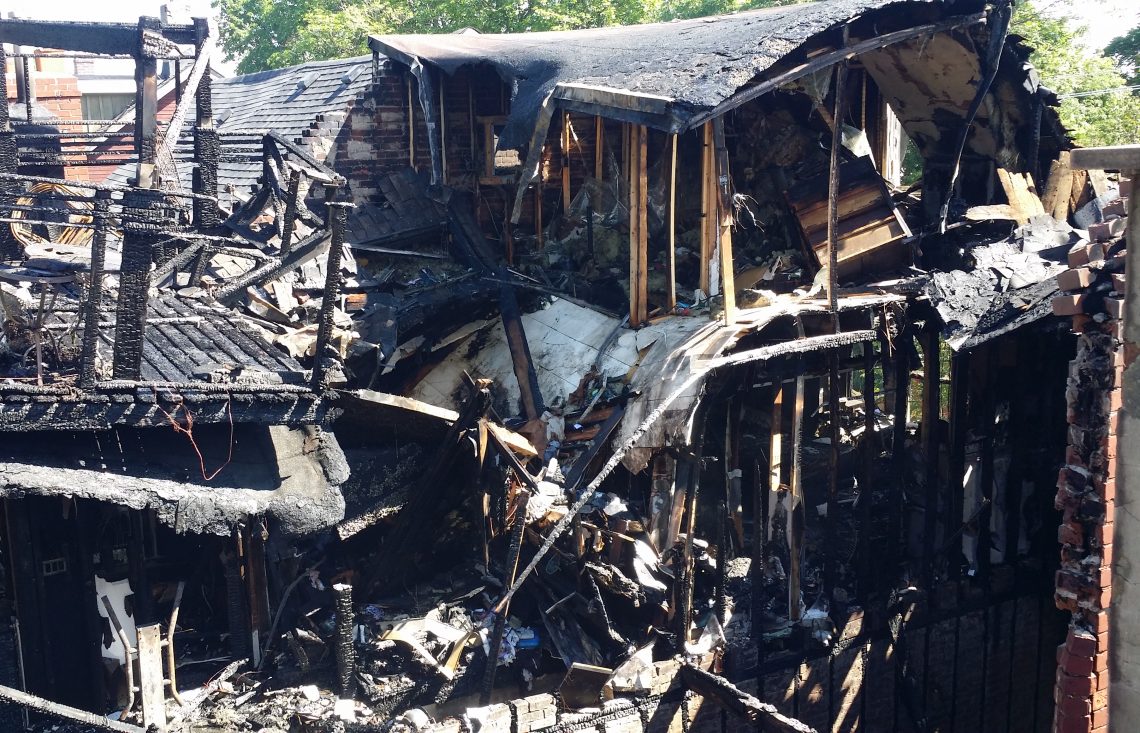
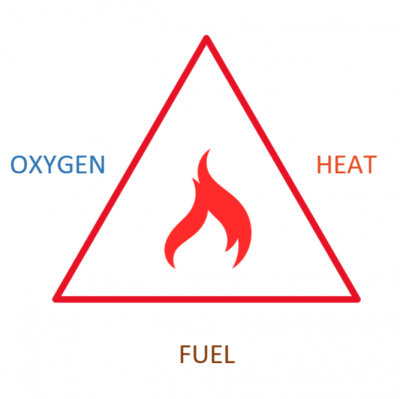
Science (just a bit)…
Likely you have heard of the fire triangle. This is the concept of the three requirements of fire;
Heat (or ignition source)
Oxygen (found in the air we breath)
Fuel (what is burning)
Removing any one of these elements will extinguish the fire. And yes you keeners out there will be muttering something about the Fire Tetrahedron to your computer screen, but let’s not unnecessarily complicate matters. Instead let’s look at how we can remove each of these elements.
Heat is most often controlled by adding water. It works well, it’s cheap, and it’s plentiful. Heat in the form of ignition sources can be controlled through prevention.
Oxygen is most often controlled by displacing it with another non flammable gas such as carbon dioxide (CO2) or Halotron. Another method is to separate the oxygen from the fuel with a blanket of fire fighting foam used by firefighters or a powder as found in most commercially available ABC handheld extinguishers. Of course the most common example that many have probably experienced, is simply putting the lid back on the pot.
Fuel can be taken out of the equation as easily as pinching the fuel line, or as we see most summers, cutting swaths through forests ahead of the windswept forest fires.
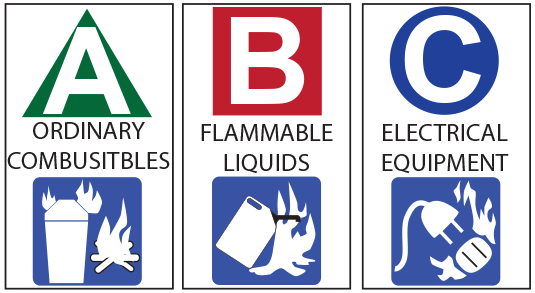
▪Class A
Ordinary combustibles such as wood, paper, cartons, textiles, and PVC.
▪Class B
Flammable liquids and gases such as, gasoline, oil, paints and propane.
▪Class C
Energized electrical equipment such as motors, appliances, electrical outlets and fuse panels.
The keeners will again point out a fourth type of fire. Class D fires are rare as they involve exotic metals that are rarely found in a hobbyist’s garage, however you may see it referenced while researching extinguishers so to satisfy any curiosity we’ll include it.
▪Class D
Combustible metals, such as sodium, magnesium and titanium.
You’ll notice that fire extinguishers are rated using the same nomenclature, symbols and often colour coding. Certain extinguishers will most effectively extinguish certain types of fires. More on that later.
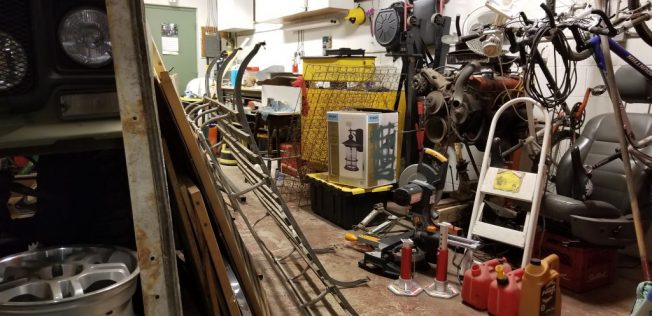
Fire Protection
Fire Hazards
Countless hazards exist in every garage. The key is eliminating as many as possible.
Most of us aren’t lucky enough to have a dedicated workshop. This space is often just as likely to be the wood shop, as it is the auto garage, paint booth, games room or even a holiday craft and scrap booking studio.
Without a doubt your garage pulls double duty as the default storage area.
Our garages are home to plastic kids’ toys, and lawn furniture, out of season clothes, cardboard boxes of ‘who knows what’ that never managed to get unpacked from the last move, lumber, sports equipment, lawn mowers, BBQ’s, winter tires, the list is exhaustive and much of it highly flammable.
Vapours from gasoline, gas/oil mix, natural gas, propane, acetylene, paints, varnishes and many cleaners, degreasers, and aerosols are all highly flammable/explosive. In terms of the fire triangle the fuel load in a typical garage is tremendous.
Many homes often have the hot water heater, and clothes dryer (often with piloted ignitions) in the garage. Many hobbyists have a source of heat such as a furnace, space heater, or a wood or oil stove. Again referring to the fire triangle the fore-mentioned are all sources of heat or ignition.
So we have already identified a ton of common fuels, and a few sources of ignition found in the average garage and we haven’t even addressed, any heat produced by the vehicles or the work you are doing, within the garage. Heat from the engine and exhaust, sparks from grinding or cutting metal, welding, soldering are all common sources of ignition.
To make all this even worse, most newer homes are built with the garage attached which adds significant risk to the entire structure and your family both from the vapours of stored chemicals, and Carbon Monoxide, but also the spread of smoke and fire.
Let’s look at some of the more common hazards a little closer.
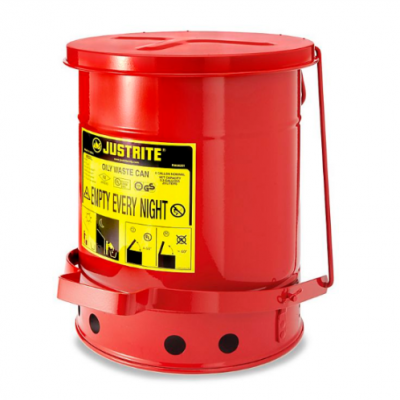
Rags and Spontaneous Combustion
Spontaneous combustion is a significant concern for many hobbyists not only because of the high risk but because of the lack of knowledge. Spontaneous combustion occurs as certain types of oils naturally decompose, in turn creating heat. If the heat can’t effectively dissipate it can build to the point of self ignition.
Rags, with these oils, paints, or wood stains (even cooking oil) on them are perfect combustibles and when piled together, can provide not only the fuel but the ignition source. Safe storage and disposal is imperative.
While gasoline, and automotive oil aren’t at risk of spontaneous combustion they are only an errant spark away from catching fire.
A good method of dealing with used rags, is to hang or lie your rags flat to dry outside the garage followed by storage in a metal can such as an unused paint can. This is particularly practical with volatiles that evaporate quickly and less so for oil saturated rags.
A couple rags here and there quickly disposed of according to your local regulations is easy to manage however if you are accumulating rags at a steady rate, using a specifically designed metal rag bucket with a gravity-closing lid is a good idea. These cans are built sturdy with integral ventilation below the can to prevent heat build up however they are quite expensive as they are tailored to industries forced to follow health and safety policies.
Watch your favorite classifieds, junk stores, and the such for good deals. Ours was generously gifted to the F-Bomb Garage by a good friend’s mother looking to clean out her own garage. Before we acquired ours we used an old galvanized steel water cooler. Any metal can with a tight fitting lid can work as a decent substitute, a steel waste can with a self closing lid is ideal.
Dispose of the rags according to local procedures and frequently so the collection is kept to a minimum and keep the can away from sources of heat.
On a related note, NEVER throw work clothes that have been in contact with oil, fuel, etc, into the clothes drier EVEN after washing. NO washer can take all traces out of the clothing and the heat from the drier can ignite a fire.
Flammable Liquids
Obviously storing chemicals and gases is a common issue in any shop or garage. Gasoline, two stroke fuel, camp fuel, oil, lubricants, propane, degreasers, cleaners, paints, stains, epoxies, glues, and resins are all just a few of an exhaustive list of common flammable products kept in the average garage.
The first step of safely storing them is to keep them in approved containers, whenever possible the same container it was sold in, with the lid tightly affixed.

An approved flammable liquids cabinet is a slick piece of gear that is designed to insulate the contents from fire while venting vapours outside the storage area. Unfortunately these cabinets are cost prohibitive for most of us. However a good source of more affordable cabinets is government auctions. For deeper cost savings there are some clever ideas for DIY cabinets online.
While not insulated or vapour proof, a salvaged metal locker is spark resistant and can make for decent storage. At the very least ensure that the storage area is placed away from ignition sources, and any areas that you may find yourself doing any hot work such as cutting, grinding or welding.
Keeping containers clean of over-spill, and keeping them well labelled is another good course of action. Gasoline should never be stored indoors. Surely everyone has seen a bulging plastic gas can due to heat fluctuations. Gasoline vapours are far more flammable than even the gas itself. Should any leak out of the can they can easily be ignited.
The most common single source of flammable liquid in the average garage is a parts cleaner. Resist the temptation to use a makeshift parts cleaner. A decent parts cleaner is very affordable and readily available used for even more savings. Most importantly a good parts washer has a fusible link that automatically drops the cover should a fire start.
If you have a parts washer keep the lid closed when not in use and avoid use of it (and any chemicals) without appropriate ventilation especially if an ignition source is present. Don’t forget any pilot lights!
While we have yet to experiment with it ourselves there are now non flammable cleaning solvents on the market. Try one of those and report back to us!
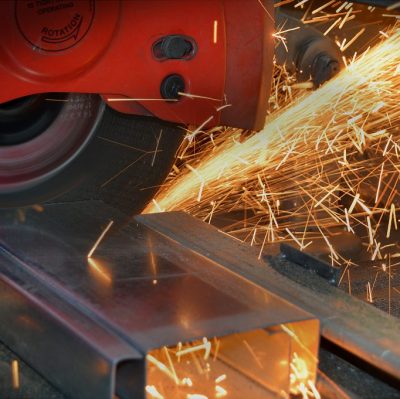
Hot Work
Hot work is any work that can create a flame, heat, or even sparks. Welding, brazing, soldering, grinding, cutting of ferrous metals and many alloys, even striking steel with steel (hammering) can cause a spark capable of igniting a fire.
The first defensive action against ignition is to keep a tidy work area. Ensuring that there are no combustibles (paper, boxes, rags, dust, wood, etc.) in the vicinity is essential. Common sense here plays a big role. The direction of sparks will change with the required
cuts. Anticipate the direction of those sparks and contain and direct them using physical barriers such as a fire blanket, welding screen or an appropriate makeshift barrier, such as sheets of metal or drywall.
Wear the proper attire while performing hot work. Frayed jeans, go up in flames in an instant, synthetics melt to the skin just as fast. Cuffed pants, and open boots catch and trap sparks. Finally plan any hot work to end well before leaving the work area. That increases the likelihood of being present should any unseen smoldering material burst into flame. Be aware a smoldering nearly undetectable fire can last for many hours before finally igniting.
Other Hazards
Some hazards unsurprisingly revolve around the vehicle itself. The two biggest hazards are the electrical and fuel systems.
Ensure that your battery is mounted securely, and both positive and ground connections are tight, and in good condition.
While most people are afraid of electricity and few would consider rewiring their own homes, it seems their vehicles are a free-for-all.
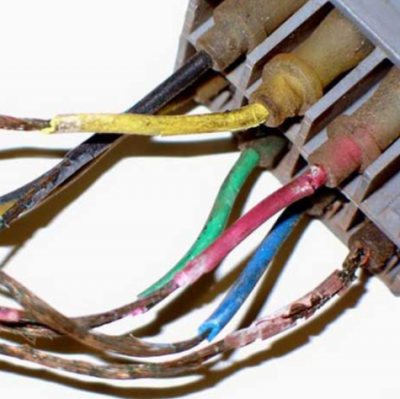
If you plan on doing any wiring on your vehicle, make sure you truly know what you are doing. Start by disconnecting the battery.
Switches can often be negatively or positively switched. Know the difference and when each should be employed. All switches should be used with an appropriate relay if you don’t know why, you probably shouldn’t be doing your own wiring.
Circuits should be appropriately fused and rarely need to be ‘hot’. The appropriate gauge wire should be used. If you don’t know how to choose the correct fuse or wire gauge once again, you probably shouldn’t be doing your own wiring. Seek assistance.
Tidy and secure connections free of loose strands, and bare wire should be ensured. Whenever possible protect wire from abrasion and the elements. Any added devices should be mounted securely and connections prevented from inadvertently shorting or grounding.
Before welding on the car, disconnect the battery.
Before working on the fuel system, disconnect the battery.
Never place your tools on the top of the battery, one slip can result in a short capable of starting a fire or causing you to jump and strike your head on the car’s hood. Don’t bother asking how we came up with that scenario.
Fuel filters should should be metal, perhaps glass, but not plastic. They should be located in a manner that prevents any leaks from falling onto a hot engine or exhaust components.
All fuel lines should be made of approved fuel line, routed away from hot surfaces whenever possible and connections should be appropriately secured and protected from abrasion.
If you are going to work on your vehicle’s fuel system, ideally pull it out of the garage first. If things go awry, losing a car, and not the garage or house is clearly preferable.
Finally never cut or drill into your vehicle without knowing for certain what is on the other side of the work surface. Compromising hidden fuel and brake lines, fuel tanks, wires, or compressed gas cylinders (bumpers, seat belts, air curtains, hatch struts, fire extinguishers – you know who you are LOL) will result in a dangerous situation at worse and a bad day at best.
We could never appropriately cover all possible hazards you may encounter so we will move on from fire protection to fire detection and suppression in Part Two. If you have some hazards you think we should have included here please let us know, we’ll do our best to address them quickly.
While the utmost care has been taken in compiling this post, mistakes may have slipped through editing. If something doesn’t seem right bring it to our attention, or ask a competent expert.
For the sake of brevity much detail has necessarily been reduced to generalizations, however for more info on anything covered in this post ask in the comments below or on our Facebook page Frontseat Driving.
This article specifically addresses fire safety for the auto enthusiast while leaving many home fire risks uncovered. Your local fire prevention department is always happy to provide resources and answer any of your questions, and is the single best resource for info regarding your local codes and best practices.
Click here for more info on Oily rag safety
Click here for a Home Fire Safety Plan